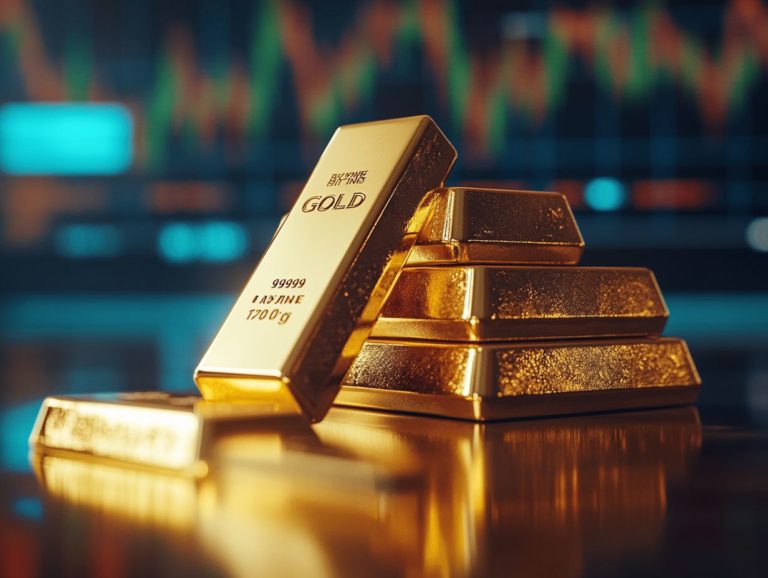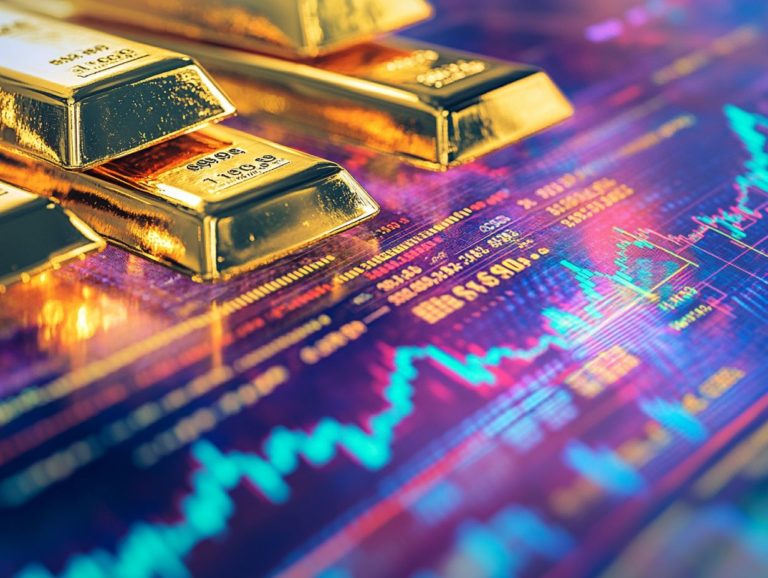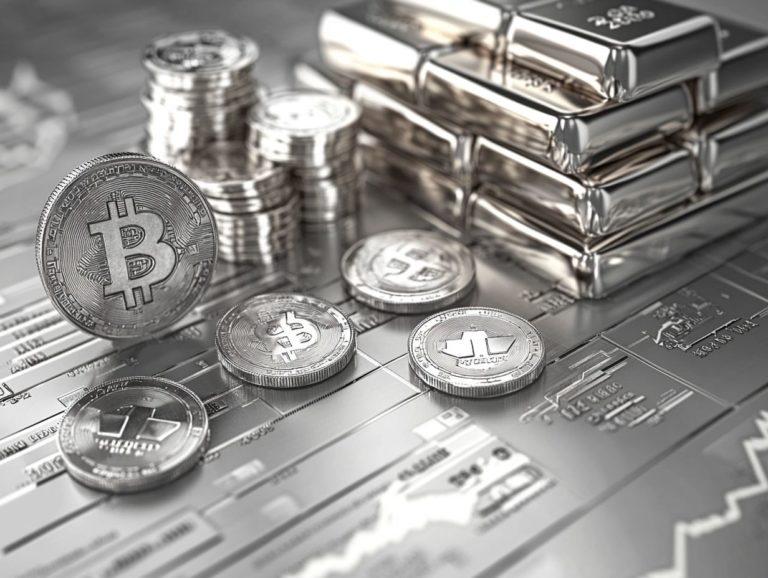Investing in Platinum: Current Market Trends
Platinum, often overlooked in favor of gold and silver, is starting to shine in the investment arena thanks to its distinct characteristics and market dynamics.
In this article, we ll explore the current trends shaping platinum, covering everything from price fluctuations to global demand and supply.
You ll discover the advantages of adding platinum to your investment portfolio, the associated risks, and practical tips for successfully navigating this precious metal market.
Whether you re a seasoned investor or just dipping your toes into platinum, you ll find valuable insights to help inform your decisions.
Contents
Key Takeaways:

- Platinum prices fluctuate with demand, supply, and economic conditions, which can make investing volatile.
- Investing in platinum helps diversify your portfolio and could yield high returns due to its rarity.
- To invest wisely, understand market trends, conduct thorough research, and select trustworthy platforms.
What is Platinum?
Platinum is a remarkable precious metal that stands out for its unique properties, making it highly desirable across various sectors, including automotive, jewelry, and investment.
Known for its rarity and exceptional durability, platinum is essential in catalytic converters devices that reduce harmful emissions from vehicles. Most of the world s platinum supply is mined in South Africa, while China and India are major consumers, driving demand in both luxury and industrial markets.
In the automotive industry, its outstanding resistance to heat and corrosion ensures longevity in exhaust systems, making it a top choice for manufacturers. They need to comply with strict environmental regulations.
Beyond its industrial prowess, the lustrous appeal and durability of platinum make it a favored option in high-end jewelry, often featured in engagement rings and luxury watches.
For investors, platinum is seen as a strategic asset, particularly in volatile markets, since it tends to retain value and can serve as a hedge against inflation.
This multifaceted metal not only plays vital roles in advancing technology and luxury but also enriches financial portfolios around the globe.
Current Market Trends
The current market trends for platinum present a sophisticated interplay of supply and demand dynamics as we look toward 2024. With a rising global investment appetite and prices that dance unpredictably, the platinum market is shaped by multiple influences.
Geopolitical tensions involving key players like Russia, along with evolving consumer preferences in significant markets like the USA and China, play crucial roles in this intricate landscape.
Price Fluctuations and Factors Affecting Them
Price fluctuations in the platinum market are influenced by a myriad of factors, including supply constraints, evolving consumer demand, and global economic conditions especially as you approach 2024.
Events like the COVID-19 pandemic have disrupted production, affecting prices and investment demand in both the automotive and industrial sectors.
Geopolitical tensions and trade policies can swiftly alter market dynamics, creating ripples that resonate with investors and businesses alike. As countries navigate their post-pandemic recovery, the demand for platinum primarily utilized in catalytic converters and as a sought-after investment remains uncertain.
Fluctuations in mining output, particularly from significant producers like South Africa and Russia, add layers of complexity to the landscape. Environmental regulations and technological advancements in recycling also play crucial roles in shaping availability, influencing prices, and ultimately impacting stakeholders across the board.
Global Demand and Supply
The global demand and supply for platinum hinge on various factors. South Africa is at the forefront, producing a significant share of the market. Meanwhile, China and the USA emerge as major consumers. The dynamics between the automotive sector, jewelry market, and investment opportunities continue to shape the availability and consumption of platinum.
The automotive industry is shifting towards electric vehicles. This change affects the demand for platinum in catalytic converters, which are devices that reduce harmful emissions in cars. In contrast, the jewelry sector, particularly in China, shows a strong appetite for precious metals, driving overall consumption higher.
Investing in platinum as a hedge against inflation adds another layer of complexity. It provides an opportunity to diversify your portfolio amidst economic uncertainties. The interaction between these sectors highlights platinum’s unique qualities and foreshadows future market trends that you must navigate as a stakeholder.
Benefits of Investing in Platinum
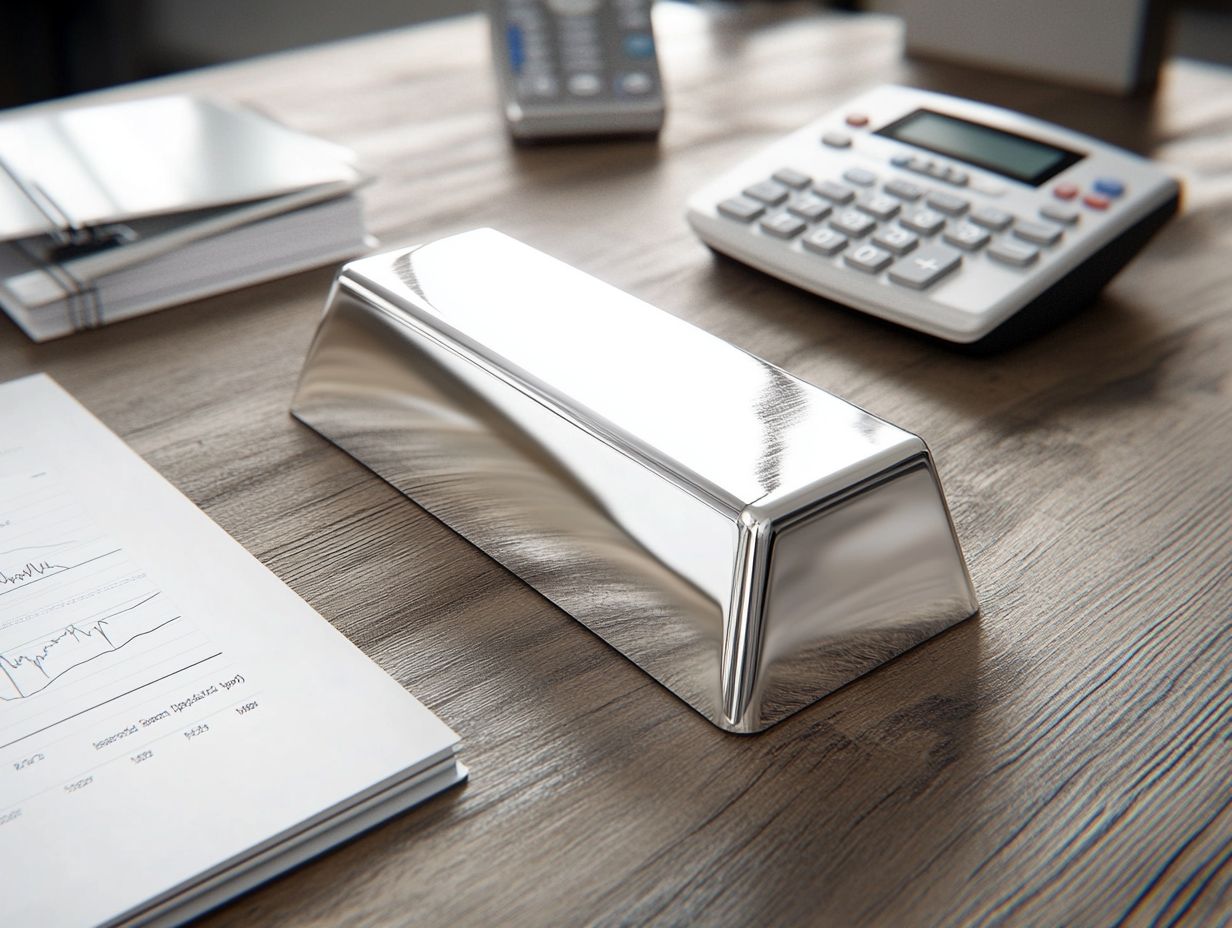
Investing in platinum presents a range of advantages, including the opportunity for diversification and appealing returns. This is particularly true in a market driven by high prices and robust global demand.
As you explore alternatives to conventional assets like gold and silver, platinum stands out as a compelling choice for enhancing your portfolio. Its distinctive properties and unique market dynamics make it an exciting investment opportunity.
Diversification and Potential Returns
Platinum offers unique opportunities for diversification. Its market behavior often deviates from traditional investments like stocks and bonds. This variability can lead to potential returns, especially during economic instability or when prices soar. It s an enticing addition to a well-rounded investment portfolio.
By incorporating platinum into your holdings, you may find yourself in a stronger position to navigate market fluctuations. As demand for this precious metal rises particularly in the automotive and electronics sectors its potential for appreciation becomes even more pronounced.
Historically, platinum has shown resilience, often performing well when other assets struggle. This makes it a compelling hedge against inflation.
By strategically allocating a portion of your investments to platinum, you can elevate your overall portfolio performance. This approach allows you to tap into a resource that enhances gains while mitigating the risks commonly associated with equity markets.
Risks of Investing in Platinum
Investing in platinum presents enticing opportunities, but it s essential to remain mindful of the inherent risks, particularly market volatility and price fluctuations.
The delicate balance between supply and demand can greatly influence your investment choices. It is imperative to evaluate the market landscape carefully before proceeding.
Market Volatility and Other Risks
Market volatility poses a significant risk in your platinum investments. It is often swayed by unpredictable global events and shifts in supply and demand dynamics. These fluctuations can lead to rapid price changes, making your investment strategies more complex and urging you to remain informed and adaptable.
Consider not just the immediate impacts of economic shifts like inflation or geopolitical tensions but also the longer-term supply chain challenges stemming from mine production issues or environmental regulations. The relationship between platinum’s industrial applications, especially in automotive catalysts and electronics, adds another layer of complexity. Demand can shift dramatically based on technological advancements and evolving consumer trends.
Navigating these intricacies requires a thorough understanding of the market landscape, giving you the power to make well-informed decisions and effectively mitigate potential losses.
How to Invest in Platinum
Investing in platinum offers a range of methods and platforms, making it accessible for both seasoned investors and newcomers.
You can choose to purchase physical platinum in the form of bars or coins, or invest in exchange-traded funds (ETFs) funds that trade like stocks on the stock market and invest in platinum. This flexibility allows you to tailor your investment strategy to align with your personal preferences and goals.
Methods and Platforms for Investing

You can explore various methods for investing in platinum. Options include purchasing physical platinum bars or coins, or utilizing platforms like ETFs that track platinum prices.
Each method presents unique advantages and considerations, enabling you to choose an approach that aligns with your financial goals.
As you weigh these options, it’s essential to understand the benefits of owning physical platinum. You gain the ability to hold and securely store the asset, although you’ll need to consider proper safety measures and potential storage costs.
ETFs offer a more passive way to invest, often featuring lower fees, liquidity benefits, and easy access through standard brokerage accounts.
However, they lack physical ownership and may be affected by market fluctuations that don’t always reflect platinum’s true value. Ultimately, your choice between these investment avenues will depend on your individual risk tolerance, investment timelines, and managing your assets.
Tips for Successful Platinum Investing
To achieve success in platinum investing, it’s essential to adopt sound strategies and insightful tips in a market characterized by fluctuating prices and shifting demand.
By understanding trends, diversifying your investments, and staying informed, you empower yourself to make astute decisions and maximize your returns.
Expert Strategies and Best Practices
Adopting expert strategies and best practices in platinum investing can enhance your ability to navigate market complexities. Key practices include conducting thorough research and understanding the inherent risks tied to price fluctuations and supply-demand dynamics.
Delve into a variety of analytical tools and resources, such as market reports and historical trends, to make informed decisions.
Utilizing reputable financial publications and dedicating time to track global economic indicators that influence platinum prices can provide clearer insights into potential investment opportunities.
Diversifying your portfolio by including physical platinum, ETFs, and mining stocks can help mitigate risks. Recognizing that market volatility can impact your investments, it’s crucial to implement prudent risk management strategies, such as setting stop-loss orders, to protect your capital while pursuing long-term gains.
Frequently Asked Questions
What is platinum and why should I consider investing in it?
Platinum is a rare and valuable precious metal used in various industries, including jewelry, automotive, and electronics. It can protect your wealth during tough economic times, making it a popular investment choice.
What are the latest trends affecting platinum prices?
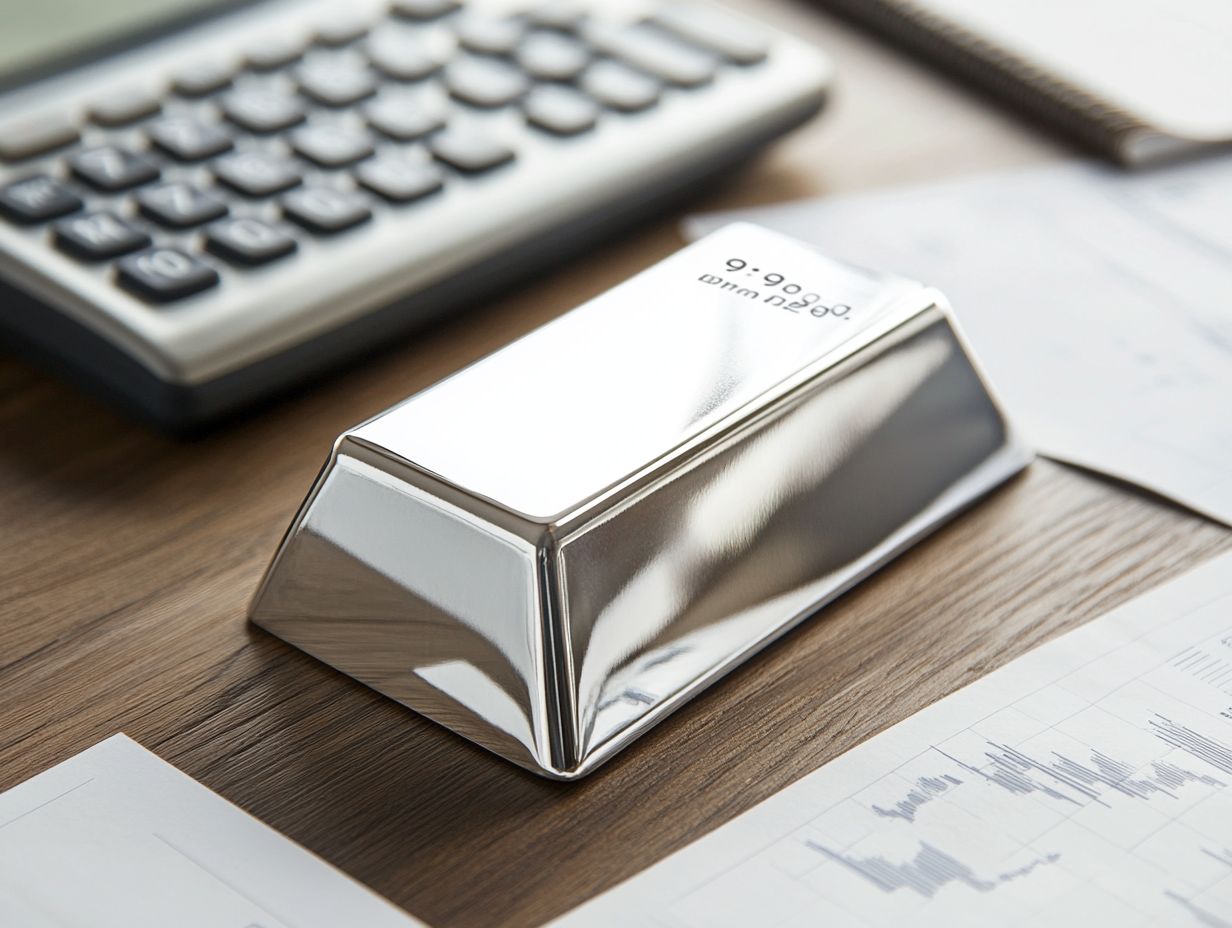
The current market trends for platinum show a decrease in supply due to ongoing mining issues and an increase in demand from sectors like electric vehicles and renewable energy. These factors are expected to drive platinum prices up in the near future.
How can I invest in platinum?
There are several ways to invest in platinum, including buying physical platinum bars or coins, investing in platinum ETFs or stocks, or purchasing shares in platinum mining companies. Research and understand the risks and potential returns of each option before making a decision.
Ready to invest in platinum? Start your journey today!
Is it a good time to invest in platinum?
The current trends for platinum are looking promising. However, consider your financial goals and how much risk you can handle before investing.
Talking to a financial advisor can provide you with useful insights.
What are the potential risks of investing in platinum?
Investing in platinum comes with risks. You might face price fluctuations, changes in supply and demand, and global events that could affect the market.
Diversifying your portfolio is essential. Always invest only what you feel comfortable with.
What are the long-term prospects for platinum as an investment?
Platinum has a history of maintaining value and offers potential for long-term growth. With its unique properties, industries will likely continue to need platinum, making it a valuable investment for years to come.










